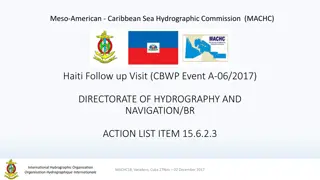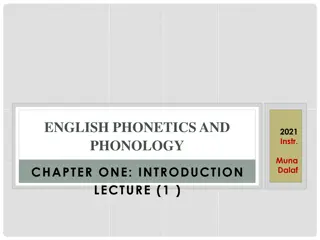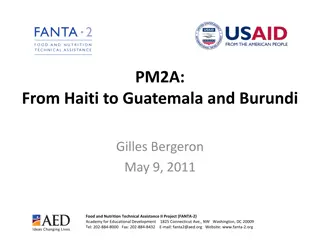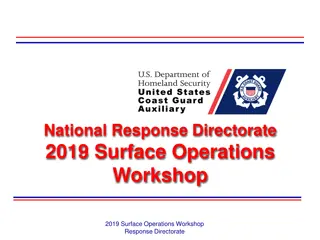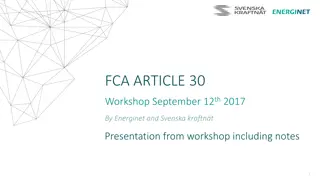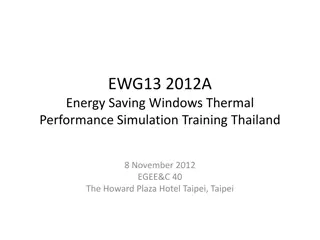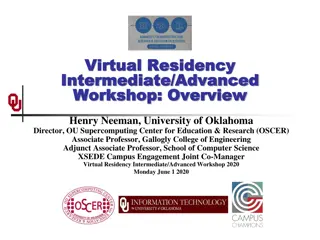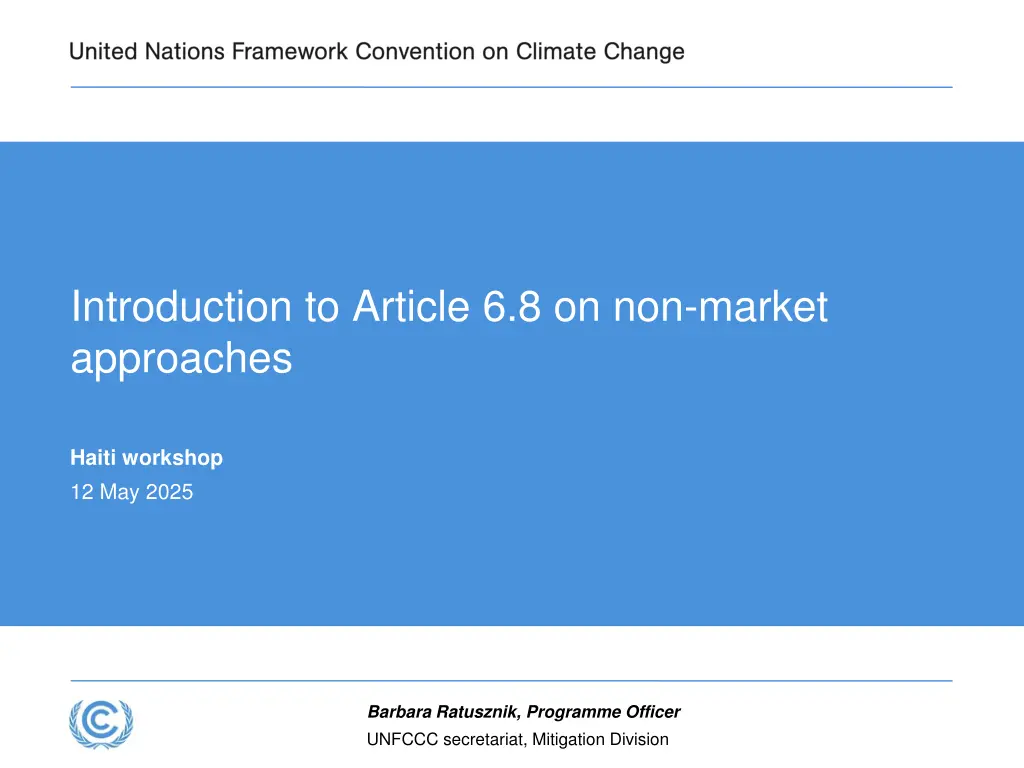
Key Decisions and Approaches Under Article 6.8 on Non-Market Strategies
Explore key decisions and definitions outlined in Article 6.8 of the Paris Agreement, focusing on non-market approaches for sustainable development and climate action. The framework emphasizes collaboration and coordination across various sectors to enhance mitigation and adaptation efforts, involving public and private sector participation.
Download Presentation

Please find below an Image/Link to download the presentation.
The content on the website is provided AS IS for your information and personal use only. It may not be sold, licensed, or shared on other websites without obtaining consent from the author. If you encounter any issues during the download, it is possible that the publisher has removed the file from their server.
You are allowed to download the files provided on this website for personal or commercial use, subject to the condition that they are used lawfully. All files are the property of their respective owners.
The content on the website is provided AS IS for your information and personal use only. It may not be sold, licensed, or shared on other websites without obtaining consent from the author.
E N D
Presentation Transcript
Introduction to Article 6.8 on non-market approaches Haiti workshop 12 May 2025 Barbara Ratusznik, Programme Officer UNFCCC secretariat, Mitigation Division
Agenda Article 6 of the Paris Agreement Article 6.8 key decisions Defining a non-market approach Glasgow Committee on Non-market Approaches (GCNMA) work programme
1.1 Article 6 of the Paris Agreement Cooperative approaches (Article 6.2) Bilateral/multilateral cooperation between interested countries, involving transfers of the mitigation outcomes produced through such cooperation The mechanism (Article 6.4) To be operated centrally (UNFCCC secretariat), credits emission reductions by public and private sector actors, allows for international transfer of those credits Framework for non-market approaches (Article 6.8) Facilitates climate action through international cooperation focused on sustainable development and poverty eradication (and does not involve trading)
1.2 Article 6 of the Paris Agreement Article 6.8 Parties recognize the importance of integrated, holistic and balanced non-market approaches being available to Parties to assist in the implementation of their nationally determined contributions, in the context of sustainable development and poverty eradication, in a coordinated and effective manner, including through, inter alia, mitigation, adaptation, finance, technology transfer and capacity building, as appropriate. These approaches shall aim to: (a)Promote mitigation and adaptation ambition; (b)Enhance public and private sector participation in the implementation of nationally determined contributions; and (c)Enable opportunities for coordination across instruments and relevant institutional arrangements. Article 6.9 A framework for non-market approaches to sustainable development is hereby defined to promote the non-market approaches referred to in paragraph 8 of this Article.
2. Article 6.8 key decisions Glasgow Established the GCNMA; meets in conjunction with the SBSTA Adopted the work programme under the framework for non- market approaches Sharm el-Sheikh Adopted the schedule of the work programme Agreed the specification for the UNFCCC web-based platform Mandated in-session workshops at Glasgow Committee meetings Dubai Established Article 6.8 National Focal Points to access the web- based platform Baku Completed an expedited and simple assessment of Phase 1 of the work programme and provided guidance for Phase 2
3.1 Defining a non-market approach Each non-market approach facilitated under the framework: Is identified by the participating Parties on a voluntary basis Involves more than one participating Party Does not involve the transfer of any mitigation outcomes Facilitates the implementation of NDCs of host Parties and contributes to achieving the long-term temperature goal of the Paris Agreement Is conducted in a manner that is consistent with the eleventh preambular paragraph of the Paris Agreement Minimizes and, where possible, avoids negative environmental, economic and social impacts
3.2 Defining a non-market approach Adaptation, resilience and sustainability Mitigation measures to address climate change and contribute to sustainable development Development of clean energy sources Additional focus areas to be identified and recommended based on experience and information from the NMA Platform
3.3 Defining a non-market approach Development of clean energy technology Capacity- building on implementing climate action Building community resilience to natural hazards Technical advice on sustainable urban infrastructure Grants or advisory services to support climate- sensitive agricultural practices
3.4 Defining a non-market approach Adaptation Benefits Mechanism (ABM) Results-based financial mechanism developed by the African Development Bank in collaboration with the governments of Uganda, Kenya, Madagascar, Benin, Gambia, Guinea and Nigeria For example, the ABM aims to support: Water and nutrition security in Uganda; and Flood and heatwave resilience in Kenya. Mobilizes finance for adaptation enables developed countries, consumers, private sector, etc. to contribute to the costs of adaptation by committing to purchase Certified Adaptation Benefits Helps fill existing gaps in metrics on adaptation by providing quantified and verified data on resilience, adaptation finance and co- benefits
3.5 Defining a non-market approach Local Climate Adaptive Living (LoCAL) Established by UNCDF to help local government authorities in developing countries finance climate adaptation In Ghana, LoCAL has channelled climate finance through 13 local authorities 8,500 mangroves seedlings planted in the Ada East District Assembly to help preserve the area s biodiversity Combines performance-based climate resilience grants with technical and capacity-building support Coconut trees planted in Winneba village around the local school to protect buildings and houses from natural hazards Operational in 20 countries; further 18 in design phase
4.1 GCNMA work programme Identifying measures for enhancing existing linkages, creating synergies and facilitating coordination and implementation of NMAs Developing and implementing tools, with the assistance of the secretariat, including the NMA Platform for recording and exchanging information on NMAs Identifying and sharing information, best practices, lessons learned and case studies in relation to developing and implementing NMAs Identifying initiatives, programmes and projects for facilitating NMAs that support the implementation of NDCs to allow for higher mitigation and adaptation ambitions in NDCs
4.2 GCNMA work programme Phase 1 2023-2024 Phase 2 2025-2026 Identifying and framing work programme activities Expedited and simple assessment of progress in Baku progress in Baku Fully implementing work programme activities, drawing on inputs from Phase 1 Expedited and simple assessment of Broadening stakeholder engagement Conducting outreach Building the capacity of Article 6.8 national focal points
4.3 GCNMA work programme Workshops Stakeholder engagement Submissions Technical papers and synthesis reports NMA Platform
Q&A session Questions







